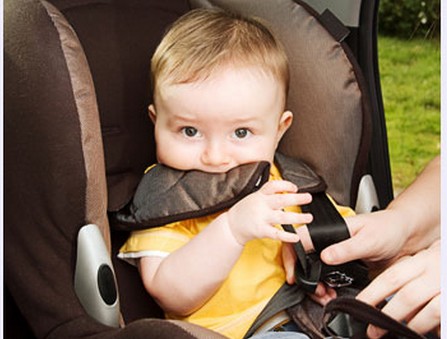Car seats and seat belts are the number one enemy of millions of freedom-loving preschoolers. These adventurous spirits don’t understand why they must be strapped down, but they can understand the rule that the car doesn’t move until the belts are on or they’re strapped in their car seats. Ensure your child’s safety every time she gets in a car by enforcing the belts-on rule. The seat-belt habit will become second nature to your child – a passenger today and a driver tomorrow – if you’re not wishy-washy about this life-or-death rule.
Every state now requires that infants and children be buckled up when riding in a motor vehicle. Approved car seats and seat belts have weight and age specifications to make car travel as safe as possible for your child. As children outgrow their infant car seats, they move to forward-facing seats, convertible seats, and eventually booster seats, depending on their age and weight.

The leading cause of death in children is trauma from automobile accidents stated by a collection of articles. Children who are not buckled up will continue to travel forward if the car stops suddenly. They will hit anything in their path, the dashboard, the windshield, or the back of the front seat, with an impact equivalent to a one-story drop for each ten miles per hour the car is traveling. Even though the dashboard and back of the front seat are padded, the impact of a crash at fifty-five miles per hour can do considerable damage to small bodies. This trauma can be prevented by making sure children are properly restrained. Never compromise the rule about being buckled up, or you may be compromising your child’s life.
Note: The infant death rate can be reduced by almost three quarters and the injury rate for one- to four-year-olds can by lowered by fifty percent by using properly installed car seats.
Give your child room to breathe.
Make sure she has room to move her hands and legs and still be safely buckled up.
Make a rule that the car will not move unless everyone “Is buckled up”.
If you enforce this rule from the beginning, your child will become accustomed to the idea of sitting in a car seat and eventually wearing a seat belt.
Make your child proud to be safe.
Tell your child why she’s graduating to a bigger car seat or using only a seat belt, to make her proud of being strapped in. For example, say, “You’re getting to be so grown-up. Here’s your new safety seat for the car!”
Don’t complain about having to wear a seat belt.
Casually telling your spouse or friend that you hate wearing a seat belt gives your child a reason to resist her belt, too.
Conduct a training program.
Let your child know how you expect her to act in a car. Take short drives around the neighborhood with one parent or friend driving and the other praising your child for sitting nicely in her car seat. Say: “You’re sitting in your car seat so nicely today,” or, “Nice sitting,” while patting and stroking her.
What to Do
Buckle yourself up.
Make sure to wear your seat belt and point out how your child is wearing one, too, to make her feel she’s not alone in her temporary confinement. If you don’t wear a seat belt, your child will not understand why she has to.
Praise staying in the seat belt.
If you ignore your child while she’s riding nicely she may look for ways to get your attention, including trying to get out of her car seat or seat belt. Keep your child out of trouble in the car by talking to her and playing word games, as well as by praising how nicely she’s sitting.
Be consistent.
Stop the car as quickly and safely as possible every time your child gets out of her car seat or seat belt, to teach her that the rule will be enforced, Say, “The car will move again only when you’re back in your car seat [or seat belt], so you will be safe”.

Divert your child’s attention.
Try activities such as number games, word games, Peek-a-Boo, singing songs, and so on, so your child won’t try to get out of her seat because she needs something to do.
What Not to Do
Don’t attend to your child’s defiant behavior, unless she unfastens her seat belt or gets out of her car seat.
Not giving attention to your child’s crying or whining while she’s belted in helps her see that there’s no benefit in protesting the seat-belt rule. Say to yourself, “I know my child is safer in her car seat and will only fight it temporarily. Her safety is my responsibility and I am fulfilling it by enforcing the seat-belt rule.”
In your article you said a forward facing seat comes after the infant seat. That is incorrect information. After an infant seat is outgrown, you get a convertible seat. It is safest for the child to remain rearfacing in the convertible seat to the stated height and weight limits of the seat, up to around age 3-4. At age 3-4, a child can safely flip the convertible seat to forward facing or move to a forward facing harnessed seat. Around age 5-6, a child can switch to a booster seat if they have outgrown their forward facing seat.